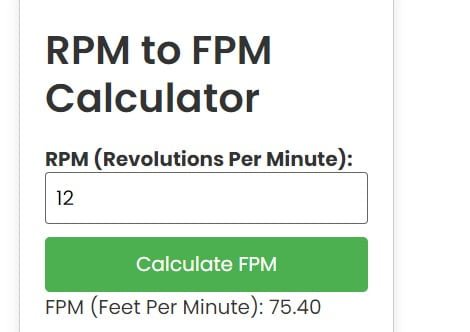In the realm of engineering, manufacturing, and industrial operations, efficiency is paramount. Whether it’s optimizing production lines, ensuring machinery operates at peak performance, or calculating the speed of rotating components, every detail matters. One crucial conversion that often arises is that of RPM to FPM. In this comprehensive guide, we’ll delve into the intricacies of RPM to FPM conversion, explore its significance, and provide a handy calculator for streamlined calculations.
Table of Contents
Understanding RPM and FPM:
Before we delve into the conversion process, let’s clarify what RPM and FPM stand for:
- RPM: Revolutions Per Minute. This metric denotes the number of full rotations completed by a rotating object in one minute.
- FPM: Feet Per Minute. FPM represents the linear speed at which a point on the circumference of a rotating object travels in one minute.
Utilizing the RPM to FPM Calculator:
To simplify the conversion process, we’ve developed a user-friendly RPM to FPM converter tool. Here’s how to use it:
- Input the RPM value into the designated field.
- Enter the diameter of the rotating object in feet.
- Click on the “Calculate” button.
- The converter will swiftly provide you with the corresponding FPM value.
The Importance of RPM to FPM Conversion:
Why is it essential to convert RPM to FPM? Consider a scenario where you need to assess the linear velocity of a rotating shaft or determine the speed of a conveyor belt. Understanding the relationship between RPM and FPM enables precise calculations, facilitating optimal machinery performance, safety, and efficiency.
The Conversion Formula:
Converting RPM to FPM involves a straightforward formula:
FPM=RPM×π×Diameter
In this equation:
- RPM represents the speed of rotation in revolutions per minute.
- π (pi) is a mathematical constant, approximately equal to 3.14159.
- Diameter refers to the diameter of the rotating object in feet.
Example Application:
Let’s illustrate the practical application of RPM to FPM conversion with an example. Suppose you’re overseeing a manufacturing plant with a rotating drum conveyor. The drum’s RPM is measured at 60 revolutions per minute, and its diameter is 3 feet. By utilizing our converter, you find that the FPM equals approximately 188.5 feet per minute. Armed with this knowledge, you can optimize conveyor speed, ensuring seamless material handling processes.
Benefits of RPM to FPM Conversion:
- Precision: By converting RPM to FPM, you gain insight into the linear velocity of rotating components with unparalleled accuracy. This precision is invaluable for optimizing processes and ensuring machinery operates within safe limits.
- Efficiency: Armed with FPM values, you can fine-tune conveyor speeds, spindle rotations, and other critical parameters to maximize operational efficiency. This optimization minimizes downtime, enhances productivity, and reduces energy consumption.
- Safety: Accurately determining FPM allows you to identify potential hazards associated with high-speed machinery. By maintaining safe operating speeds, you mitigate the risk of accidents, safeguarding personnel and equipment.
- Versatility: RPM to FPM conversion finds application across diverse industries, including manufacturing, automotive, aerospace, and more. Whether you’re designing new equipment or troubleshooting existing systems, this conversion is a versatile tool in your arsenal.
Conclusion:
In the dynamic landscape of industrial operations, precision and efficiency reign supreme. By mastering RPM to FPM conversion, engineers, technicians, and manufacturing professionals equip themselves with a valuable tool for enhancing productivity and safety. Our RPM to FPM converter empowers you to make informed decisions, streamline processes, and unlock the full potential of your machinery. Embrace efficiency with confidence, and propel your operations to new heights.
In conclusion, RPM to FPM conversion is not just a mathematical exercise; it’s a cornerstone of efficient industrial operations. With the right knowledge and tools at your disposal, you can navigate complex calculations effortlessly, ensuring optimal performance and safety across diverse applications.
FAQs
How do you convert FPM to RPM?
Converting Feet Per Minute (FPM) to Revolutions Per Minute (RPM) involves rearranging the RPM to FPM conversion formula. Here’s the formula:
RPM=FPM/(π×Diameter)
Where:
- RPM represents the speed of rotation in revolutions per minute.
- FPM denotes the linear speed in feet per minute.
- π (pi) is a mathematical constant, approximately equal to 3.14159.
- Diameter refers to the diameter of the rotating object in feet.
How do you convert RPM to surface feet per minute?
To convert RPM to surface feet per minute (SFPM), you can use the following formula:
SFPM=RPM×Diameter×π
Where:
- SFPM represents the surface speed in feet per minute.
- RPM denotes the speed of rotation in revolutions per minute.
- Diameter refers to the diameter of the rotating object in feet.
- π (pi) is a mathematical constant, approximately equal to 3.14159.
How do you convert RPM to Ft/s?
To convert RPM to feet per second (Ft/s), you’ll first need to convert RPM to FPM using the formula provided earlier. Once you have the FPM value, you can then convert it to feet per second. The conversion from FPM to Ft/s is straightforward:
Ft/s=FPM/60
Where:
- Ft/s represents the speed in feet per second.
- FPM denotes the linear speed in feet per minute.
What is speed FPM?
Speed FPM refers to the linear speed of a rotating object, typically expressed in feet per minute (FPM). It indicates how fast a point on the circumference of the rotating object travels in one minute.
What is 1 RPM equal to?
One RPM (Revolution Per Minute) denotes one complete revolution of a rotating object in one minute. It represents the angular velocity of the object and is commonly used to measure rotational speed.
How is FPM calculated?
FPM (Feet Per Minute) is calculated by multiplying the RPM (Revolutions Per Minute) of a rotating object by the circumference of the object. The formula for calculating FPM is:
FPM=RPM×π×Diameter
Where:
- FPM represents the linear speed in feet per minute.
- RPM denotes the speed of rotation in revolutions per minute.
- π (pi) is a mathematical constant, approximately equal to 3.14159.
- Diameter refers to the diameter of the rotating object in feet.


